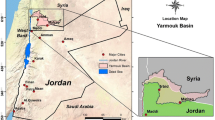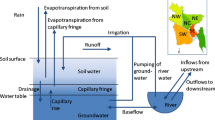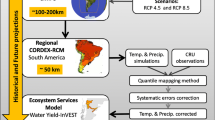Abstract
Central Asia is facing an unprecedented juxtaposition of regional climate- and water-related issues, emphasised by a changing climate. We investigate the potential impact of long-term climate change on the availability of water resources in the Amu Darya River, one of the two major rivers that feed the Aral Sea, and its effect on irrigation in the region. Using a water balance accounting model developed for the Amu Darya basin, we find that projected increases in summer temperatures of up to 5 °C by 2070–2099 under a high-emission scenario, combined with likely shifts in the seasonality of precipitation, would lead to an increase in crop water consumptive demand of between 10.6 and 16 % (or between 3.7 and 5.5 km3 y−1) relative to 1961–1990. By the end of the century, 34 to 49 % of the basin’s existing 3.4 million ha of irrigated land would go unirrigated in a 1:20 year drought. Runoff is also expected to decline by between 10 and 20 % on current levels, however contributions to river flows from unsustainable glacial retreat and snow-melt are likely to remain small. While the uncertainty surrounding the precipitation projections is high, the effect of increased temperatures on irrigation practices in the basin is more robust in the long-term.





Similar content being viewed by others
References
Agal’tseva NA, Spectorman T, White CJ, Tanton TW (2010) Modelling the future climate of the Amu Darya basin. In: Olsson O, Bauer M (eds) Interstate Water Resource Risk Management: Towards a sustainable future for the Aral Basin, IWA Publishing, pp 9–32, ISBN 9781843393085
Agal’tseva NA, Bolgov MV, Yu Spektorman T, Trubetskova MD, Chub VE (2011) Estimating hydrological characteristics in the Amu Darya River basin under climate change conditions. Russ Meteorol Hydrol 36:58–69
Akhtar F, Tischbein, Khalid B, K U (2013) Optimizing deficit irrigation scheduling under shallow groundwater conditions in lower reaches of Amu Darya River Basin. Water Resour Manag 27:3165–3178
Aus der Beek T, Voß F, Flörke M (2011) Modelling the impact of global change on the hydrological system of the Aral Sea Basin. Phys Chem Earth 36:684–695
Awan UK, Tischbein B, Conrad C, Martius C, Hafeez M (2011) Remote sensing and hydrological measurements for irrigation performance assessments in a water user association in the Lower Amu Darya River basin. Water Resour Manag 25(10):2467–2485
Badescu V, Schuiling RD (2010) Aral Sea; irretrievable loss or Irtysh imports? Water Resour Manag 24:597–616
Bagla P (2009) No sign yet of Himalayan meltdown, Indian report finds. Science 326(5955):924–925
Barlow MA, Tippett MK (2008) Variability and predictability of central Asia river flows: antecedent winter precipitation and large-scale teleconnections. J Hydrometeorol 9:1334–1349
Bernauer T, Siegfried T (2012) Climate change and international water conflict in Central Asia. J Peace Res 49:227–239
CAWATERinfo (2012) Water resources of the Amu Darya River basin. Portal of Knowledge for Water and Environmental Issues in Central Asia. http://www.cawater-info.net/amudarya/water_e.htm. Accessed 05 September 2012
Christensen JH, Hewitson B, Busuioc A et al (2007) Regional climate projections. In: Solomon S, Qin D, Manning M et al (eds) Climate change: the physical science basis. Contribution of working group I to the fourth assessment report of the intergovernmental panel on climate change. Cambridge University Press, London
Cogley JG, Kargel JS, Kaser G, van der Veen CJ (2010) Tracking the source of glacier misinformation. Science 327(5965):522
EDB (2008) EDB Eurasian integration yearbook 2008. Eurasian Development Bank (EDB), Almaty
EDB (2009) Impact of climate change to water resource in Central Asia. Eurasian Development Bank (EDB), Almaty
FAO CROPWAT (1998) CROPWAT: a computer program for irrigation planning and management. FAO Irrigation and Drainage No. 46, Rome
FAO AQUASTAT (2011) AQUASTAT: global information system on water and agriculture. FAO Water. http://www.fao.org/NR/WATER/AQUASTAT/main/index.stm. Accessed 04 July 2011
Glantz MH (2005) Water, climate, and development issues in the Amu Darya basin. Mitig Adapt Strateg Glob Chang 10:23–50
Granit J, Jägerskog A, Lindström A et al (2012) Regional options for addressing the water, energy and food nexus in Central Asia and the Aral Sea Basin. Int J Water Res D 28(3):419–432
Grübler A, O’Neill B, Riahi K et al (2007) Regional, national, and spatially explicit scenarios of demographic and economic change based on SRES. Technol Forecast Soc Chang 74:980–1029
Hewitson B (2003) Developing perturbations for climate change impact assessments. Eos 84(35):337–348
Immerzeel WW, van Beek LPH, Bierkens MFP (2010) Climate change will affect the Asian water towers. Science 328(5984):1382–1385
Jalilov S-M, Amer SA, Ward FA (2013) Water, food, and energy security: an elusive search for balance in central Asia. Water Resour Manag 27:3959–3979
Konovalov VG (2007) Past and prospective change in state of Central Asian glaciers. In: Glaciers in Watershed and Global Hydrology. International Commission on Snow and Ice Workshop, Austria, August 2007
Krysanova V, Dickens C, Timmerman J et al (2010) Cross-comparison of climate change adaptation strategies across large river basins in Europe, Africa and Asia. Water Resour Manag 24:4121–4160
Malone EL, Melnyk M, Yarrow K, et al. (2010) Changing glaciers and hydrology in Asia: Addressing vulnerabilities to glacier melt impacts. USAID
Meehl GA, Covey AC, Delworth T et al (2007) The WCRP CMIP3 multi-model dataset: a new era in climate change research. Bull Am Meteorol Soc 88:1383–1394
Meybeck M (2003) Global analysis of river systems: from earth system controls to anthropocene syndromes. Philos Trans R Soc Lond B 358(1440):1935–1955
Mitchell TD, Jones PD (2005) An improved method of constructing a database of monthly climate observations and associated high-resolution grids. Int J Climatol 25:693–712
Monteith JL (1965) Evaporation and environment. Symp Soc Exp Biol 19:205–224
Oki T, Kanae S (2006) Global hydrological cycles and world water resources. Science 313(5790):1068–1071
Olsson O (2009) JAYHUN–Transboundary water resources management in the Amu Darya basin for a sustainable future of the Aral Sea basin. Hydrol Wasserbewirtsch 53(4):271–272
Parry ML, Canziani OF, Palutikof JP, Van Der Linden PJ, Hanson CE (2007) Climate change: impacts, adaptation and vulnerability. Contribution of working group II to the fourth assessment report of the intergovernmental panel on climate change. Cambridge University Press, London
Penman HL (1948) Natural evaporation from open water, bare soil and grass. Proc R Soc A 194:120–145
Ragab R, Prudhomme C (2002) Climate change and water resources management in arid and semi-arid regions: prospective and challenges for the 21st century. Biosyst Eng 81(1):3–34
Rycroft DW (2010) WEAP - modelling of Amu Darya water resources. In: Olsson O, Bauer M (eds) Interstate Water Resource Risk Management: towards a sustainable future for the Aral Basin, IWA Publishing, 61–72
SEI (1999) WEAP 21: water evaluation and planning system. stockholm environment institute (SEI). Available at http://www.weap21.org
Siegfried T, Bernauer T, Guiennet R et al (2012) Will climate change exacerbate water stress in Central Asia. Climate Change 12(3):881–899
Solomon S, Qin D, Manning M et al (2007) Climate change: the physical science basis. Contribution of working group I to the fourth assessment report of the intergovernmental panel on climate change. Cambridge University Press, London
Sorg A, Bolch T, Stoffel M, Solomina O, Beniston M (2012) Climate change impacts on glaciers and runoff in Tien Shan (Central Asia). Nat Clim Chang 2:725–731
Spoor M, Krutov A (2003) The power of water in a divided Central Asia. Perspect Glob Dev Technol 2(3–4):593–614
Stanchin I, Lerman Z (2006) Water in Turkmenistan. Water, Security and Sustainable Development in Central Eurasia workshop, The Hague, 1–2 December, 2006
UNECE (2011) Drainage basin of the Aral Sea and other transboundary waters in Central Asia. Second assessment of transboundary rivers, lakes and groundwaters. United Nations Economic Commission for Europe (UNECE), New York and Geneva, pp 107–130
Varis O, Kummu M (2012) The major central Asian river basins: an assessment of vulnerability. Int J Water Res D 28(3):433–452
Vörösmarty CJ, McIntyre PB, Gessner MO et al (2010) Global threats to human water security and river biodiversity. Nature 467:555–561
Acknowledgments
European Union Framework 7 funding supported this work as part of the ‘JAYHUN - Transboundary water resources management in the Amu Darya basin for a sustainable future of the Aral Sea basin’ project.
Author information
Authors and Affiliations
Corresponding author
Rights and permissions
About this article
Cite this article
White, C.J., Tanton, T.W. & Rycroft, D.W. The Impact of Climate Change on the Water Resources of the Amu Darya Basin in Central Asia. Water Resour Manage 28, 5267–5281 (2014). https://doi.org/10.1007/s11269-014-0716-x
Received:
Accepted:
Published:
Issue Date:
DOI: https://doi.org/10.1007/s11269-014-0716-x




